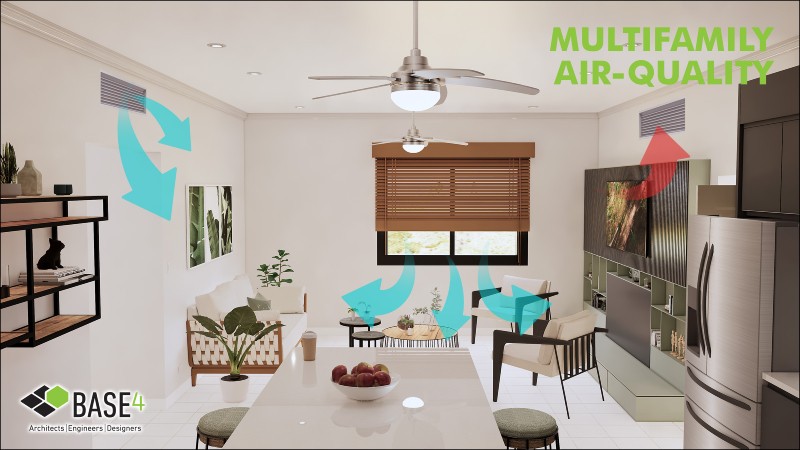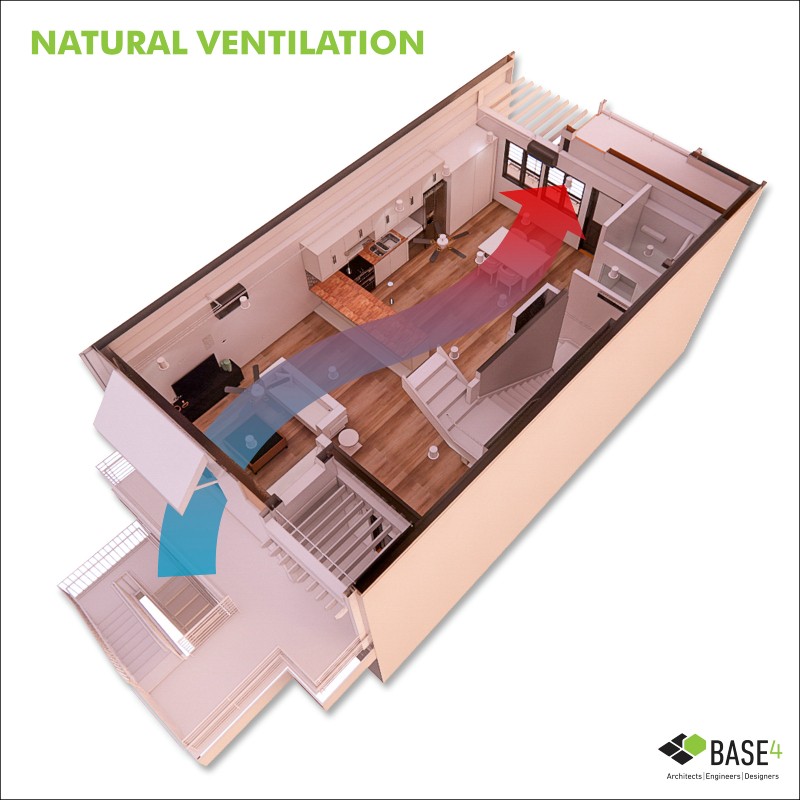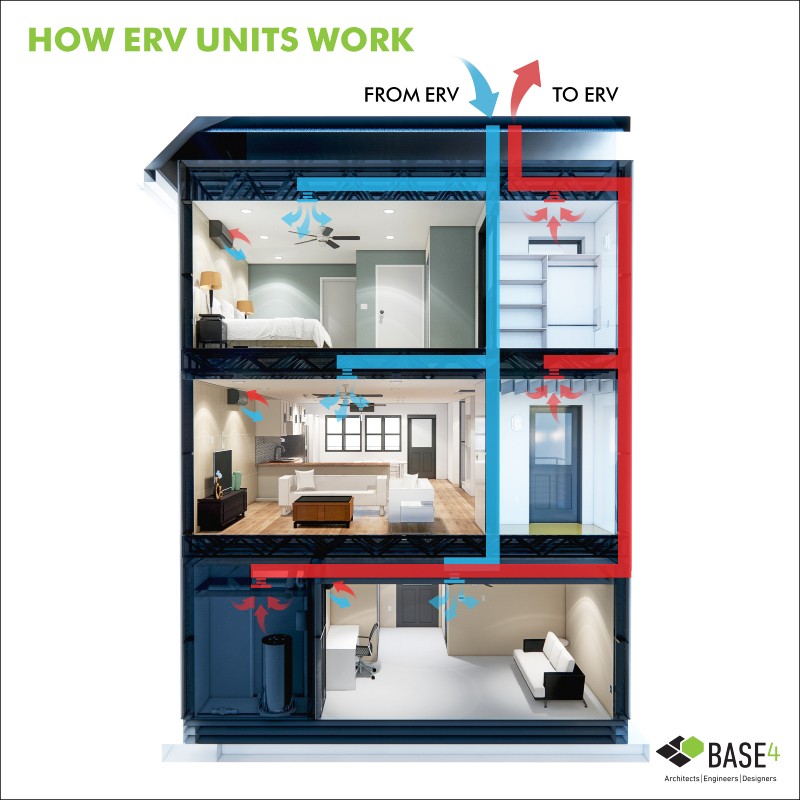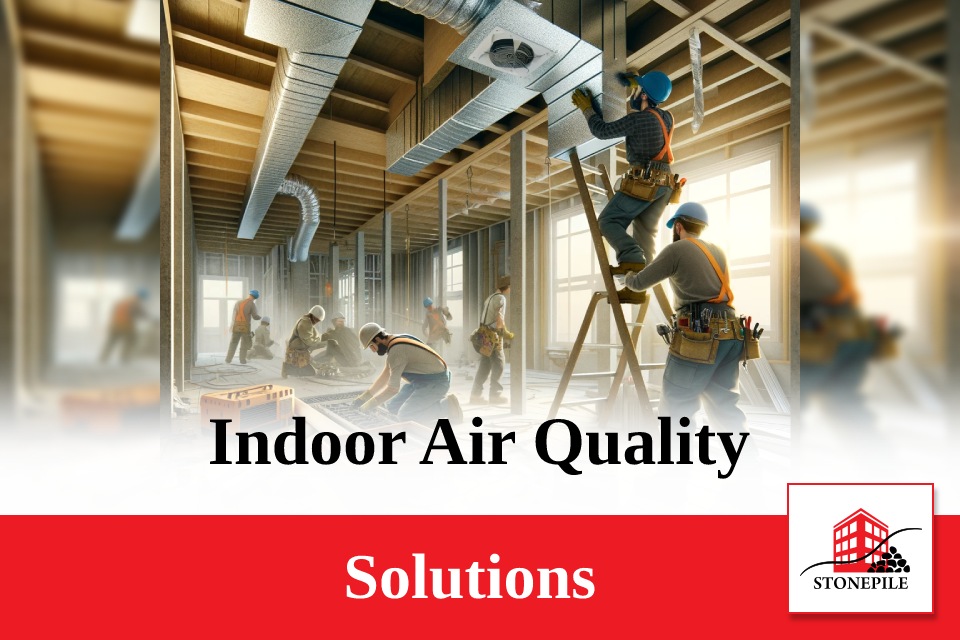In the multifaceted domain of multifamily building design, ventilation emerges as a linchpin for ensuring the health and comfort of occupants. Ventilation acts as the respiratory system of a building, facilitating the refreshment and oxygenation of indoor air. Without robust ventilation, occupants may encounter a myriad of health-related challenges, underscoring the importance of selecting the optimal ventilation system. Let’s delve deeper into this pivotal aspect of construction and examine its profound implications for indoor air quality (IAQ).
A Breath of Fresh Air: Understanding Indoor Air Quality
Indoor Air Quality (IAQ) encapsulates various factors influencing the quality of air within and around buildings, directly impacting occupants’ health and comfort. By augmenting the influx of outdoor air, buildings can effectively regulate pollutant levels, mitigate odors, control temperature and humidity, and ultimately enhance the overall well-being of their occupants.

Ventilation
Ventilation can be broadly classified into two primary categories: natural and mechanical.
Natural Ventilation
Natural ventilation capitalizes on natural phenomena such as wind pressure and variations in air density to facilitate airflow through openings like windows and doors. Regulatory standards outlined in the International Mechanical Code (IMC) section 402 and ASHRAE 62.2 mandate compliance with minimum requirements for natural ventilation systems. These standards stipulate that the openable area to the outdoors should constitute at least 4% of the total floor area being ventilated, ensuring sufficient airflow and ventilation efficacy.
Natural ventilation, beyond its regulatory compliance, offers a host of benefits. It not only fosters energy efficiency by reducing reliance on mechanical systems, thereby lowering operational costs and minimizing environmental impact but also enhances occupants’ connection to the outdoor environment. This promotes a sense of well-being and comfort and can even improve productivity and mental health.

Advantages of Natural Ventilation
- Energy Efficiency: By harnessing natural airflow, natural ventilation reduces the need for mechanical systems, leading to energy savings and lower operational costs.
- Improved Indoor Environment: Natural ventilation brings in fresh outdoor air, reducing indoor pollutants and creating a healthier living environment for occupants.
- Enhanced Comfort: The ability to open windows and doors provides occupants with control over their indoor environment, enhancing comfort and satisfaction.
Mechanical Ventilation: Engineered Efficiency
In contrast, mechanical ventilation relies on powered equipment such as fans and blowers to supply or extract air from indoor spaces. This method offers precise control over airflow rates and distribution, making it particularly suitable for buildings where natural ventilation may be inadequate or impractical. Compliance with regulations outlined in IMC section 403 and ASHRAE 62.2-2019 is imperative to ensure the proper design and installation of mechanical ventilation systems. Additionally, energy efficiency standards such as ASHRAE Standard 90.1 often mandate the integration of energy recovery mechanisms to optimize system performance and minimize operational costs.
Advantages of Mechanical Ventilation
- Precision Control: Mechanical ventilation systems allow for precise control over airflow rates and distribution, ensuring consistent indoor air quality.
- Adaptability: Mechanical ventilation systems can be tailored to suit the specific needs of multifamily buildings, accommodating diverse climatic conditions and occupancy patterns.
- Enhanced Filtration: Mechanical ventilation systems can incorporate advanced filtration technologies, effectively removing pollutants and allergens from indoor air.
Energy Recovery Ventilation (ERV) Systems
Energy Recovery Ventilation (ERV) systems represent a sustainable and energy-efficient solution for ventilation needs in multifamily buildings. These systems employ a heat exchanger to transfer heat and moisture between incoming and outgoing air streams, allowing for the recovery of energy that would otherwise be lost during ventilation. By pre-conditioning the incoming air with the energy from the exhaust air, ERV systems reduce the overall cooling or heating load of the building, leading to significant energy savings and operational cost reductions.
Benefits of ERV Systems
- Energy Efficiency: ERV systems minimize the energy required for heating and cooling by recovering energy from the exhaust air stream.
- Improved Indoor Air Quality: By exchanging stale indoor air with fresh outdoor air while retaining energy, ERV systems enhance indoor air quality without compromising energy efficiency.
- Moisture Control: ERV systems help regulate indoor humidity levels by transferring moisture between air streams, preventing issues such as mold growth and moisture-related damage.

Navigating Code Requirements: The Role of Mechanical Ventilation Systems
Mechanical ventilation systems must adhere to specific code requirements, particularly those delineated in ASHRAE 62.2. Continuous dwelling unit ventilation with an outdoor unit is mandated, with prescribed airflow rates specified in section 4.1.1. Energy Recovery Ventilation (ERV) units present a sustainable and energy-efficient alternative, leveraging exhaust air to precondition incoming air and mitigate the overall cooling or heating load.
Optimizing Ventilation Systems for Multifamily Dwellings
Innovations in HVAC technology continue to revolutionize the way we approach ventilation systems, offering cutting-edge solutions to enhance indoor air quality and occupant comfort in multifamily dwellings. Effective ventilation facilitates adequate air exchange, removes pollutants and contaminants, and enhances overall comfort levels for occupants. By selecting the appropriate ventilation approach—whether natural, mechanical, or utilizing ERV systems—construction professionals can create indoor environments that prioritize occupants’ health and well-being.
In summary, ventilation serves as a cornerstone in determining indoor air quality in multifamily buildings, directly influencing occupants’ health, comfort, and productivity. For contractors, engineers, architects, and modular experts, understanding and implementing effective ventilation strategies are pivotal for ensuring the success and sustainability of their projects. By adhering to regulatory standards and embracing innovative ventilation solutions, construction professionals can create indoor environments that foster well-being and elevate the overall quality of life for occupants.
Conclusion:
In conclusion, optimizing ventilation systems is not only crucial for the health and comfort of occupants in multifamily buildings but also aligns with the core principles of construction education and career advancement. Whether through natural or mechanical approaches, adherence to industry standards ensures that professionals can become subject matter experts in HVAC, plumbing, electrical systems, architecture, structural design, and other relevant fields. By offering comprehensive online construction courses, including modules on modular construction techniques, individuals can access specialized training and professional development opportunities tailored to their needs.
Moreover, the emphasis on proper ventilation underscores the commitment to fostering a thriving construction community where networking opportunities abound, and industry leaders share insights and news. Through engagement with peers and access to construction industry resources, professionals gain valuable knowledge and stay abreast of the latest developments in the field. Ultimately, by prioritizing ventilation in multifamily building design, we not only create healthier environments but also contribute to the ongoing advancement and innovation within the construction industry.
Source:
Developers: Apartment Fresh Air 101 – BASE4 (base-4.com)
Stay connected on our social media.


